Nearly a Year Into Whole Foods’ Pollinator Health Policy, Suppliers Share Lessons Learned


(Image courtesy of Whole Foods.)
By now, we're probably all familiar with some kind of “save the bees” messaging. We may even have some understanding of the alarming decrease in bee populations since the 1990s. The fact that’s often less apparent is how the bee crisis quickly translates to a food crisis, not just for humans but many other organisms that depend on their pollination.
Whole Foods Market has championed environmental stewardship as a part of its core values for some time. It’s this long-standing conversation with suppliers that allowed for ease of transition with its new pollinator health policy, Caitlin Leibert, the company’s vice president of sustainability, said during a recent Trellis webinar.
“It starts with talking with our suppliers and better understanding the incredible work that they're already doing,” Leibert said. “We could not have made this policy as quickly as we did if the gap was so large. We've been talking for years with our key suppliers about the value of this.”
This policy fundamentally mandates that all Whole Foods fresh produce and floral suppliers implement a pest management system that reduces the need for chemical pesticides by 2025. It also prohibits the use of nitroguanidine and neonicotinoids in potted plants by that time. These are groups of pesticides that can be particularly harmful to some insects, including bees and other pollinators. While these chemicals are intended to ward off pests that destroy and damage crops, they also affect major ecosystem engineers like bees. At the least, they affect the foraging, reproduction and flying ability of pollinators.
On a micro level, the use of these pesticides will reduce a growers’ crop or flower yield in the short term, but on a macro level it will aggravate the decline of the wild pollinator population. At least one third of the world’s food is produced with the help of pollinators. Flowers and ornamentals will also take a huge hit. So, pollinator loss can have a serious impact on our food systems.
Whole Foods’ new pollinator policy demonstrates the role companies can play in driving change and making sustainable choices more available to consumers. By ensuring its suppliers comply with a method of agriculture that considers the health of keystone species like pollinators, Whole Foods is giving consumers an option to support conservation.
“At Whole Foods, we believe food can and should be a force for good and positive change in our communities and environment,” Leibert said. “Because of that, you really have to sort of codify that in a policy to drive change. It's not enough to say we care, that's important, that's step one. But in order to drive meaningful change, we really have to think about policy.”
The company announced the new policy in December, but it won’t take full effect until 2025, which gives suppliers time to create a transition plan. In the meantime, some of its longtime suppliers that have been a part of the conversations that birthed the policy are helping share alternative practices.
“We're partnering with suppliers like Rainier Fruit to promote pollinator-friendly practices, including dedicated pollinator habitats and Bee Better certified orchards,” Leibert said. “Again, I think what's really important about this policy is that ... it starts with talking to our farmers.”
Dedicated habitats and achieving Bee Better certification, which ensures farms are practicing pollinator and biodiversity conservation, are a great start. Some suppliers have already begun to make the switch. But beyond that, Whole Foods understands they might need additional support to make the transition.
“We certainly provide technical tools as needed,” Leibert said. “I think Rainier [Fruit] is a really good example of that. We have a long history of investing within our supply system, as well.”
A network of suppliers sharing best practices isn’t new to Whole Foods. In 2021, the company implemented a regenerative agriculture policy that employed a similar information-sharing method to ease the transition for suppliers. And these policies don’t just come from anywhere.
“I think our quality standards team is such a unique team,” Leibert said. “There are around 20 subject matter experts, everything from animal welfare to seafood to agricultural practices. So the credit goes to this team largely for creating this policy. They're the policy experts. What's really cool about this work though is, again, the theme of interconnectedness. We want to make sure that when we're talking about pollinator health, we're not doing so in a vacuum. We're recognizing it as a key part within a larger resilient climate and nature health.”
For MVP Dairy, Regenerative Farming is About Progress Over Perfection
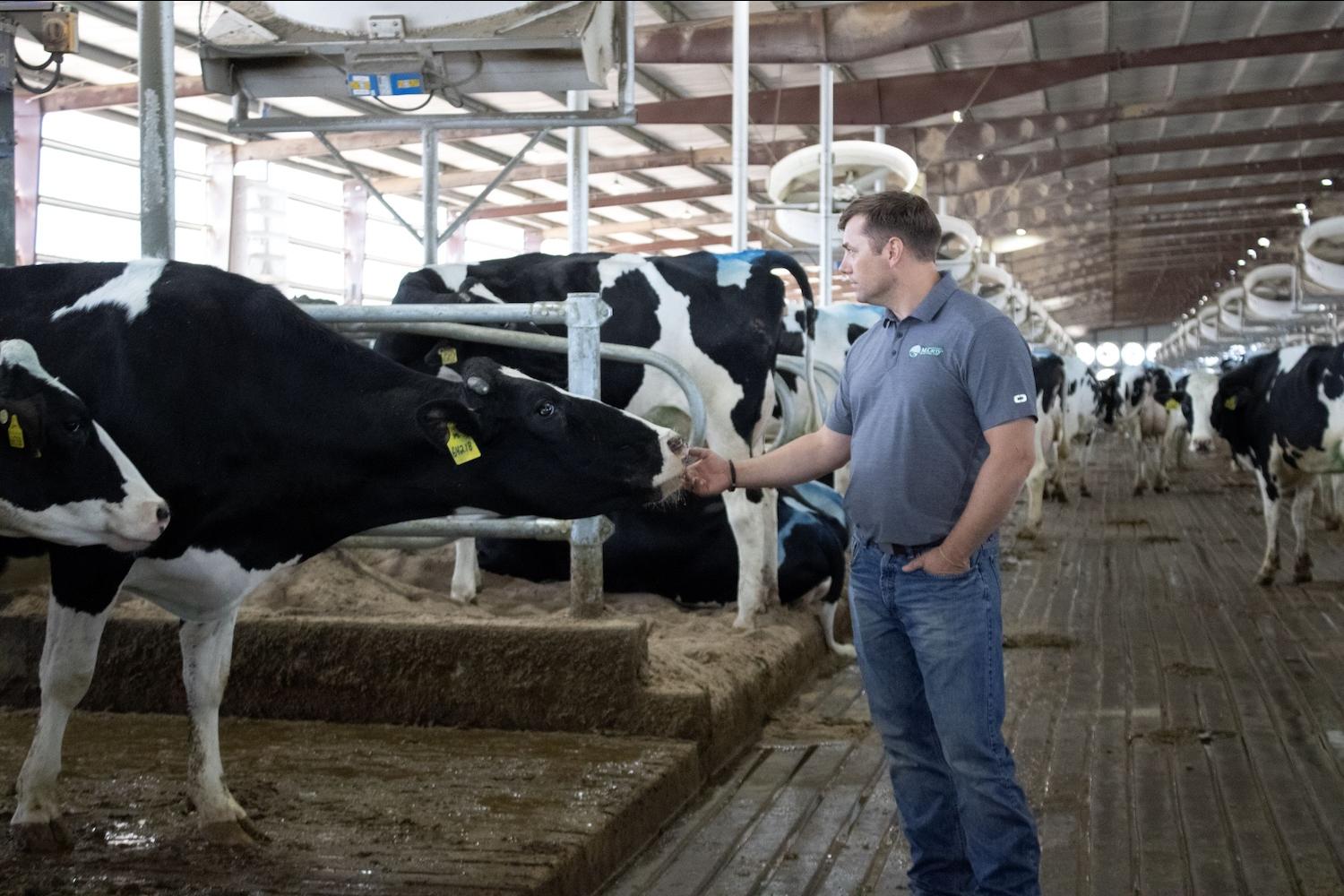
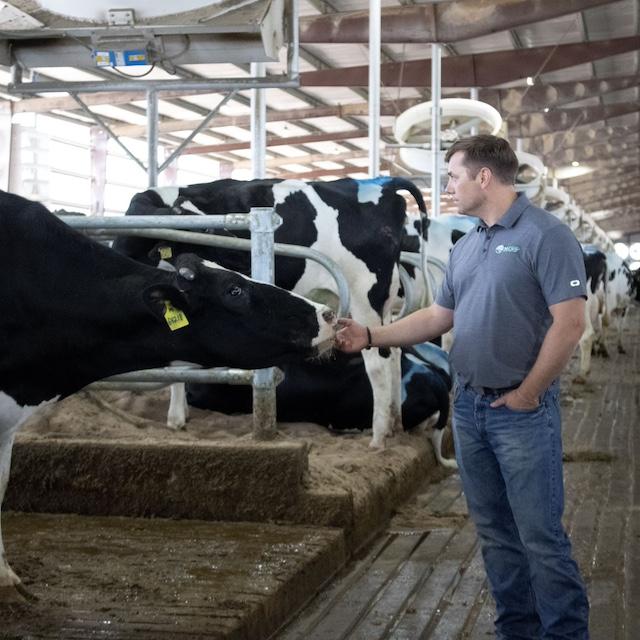
Ken McCarty of MVP Dairy walks through one of the farm's barns in Celina, Ohio. (Image courtesy of MVP Dairy.)
As climate concerns intensify, one particular source of emissions, animal agriculture, has come under intense scrutiny due to its contribution to global greenhouse gas emissions. Animal agriculture accounts for roughly 14.5 percent of the world’s total emissions, according to the United Nations Food and Agriculture Organization.
Cattle farming in particular poses several environmental challenges, primarily due to methane emissions, an especially potent greenhouse gas. Livestock and feed production are often drivers of deforestation, habitat loss and water consumption, leaving many to wonder if cattle farming can coexist in a world increasingly focused on decarbonization and biodiversity.
When asked if animal agriculture can ever be compatible with a sustainable, healthy planet, fourth-generation dairyman Ken McCarty said, “I spend a lot of time thinking about that. What I think it comes down to is that we all have to eat. As global populations increase and demand for protein increases, we as food producers have a responsibility to the world to do as good a job as we possibly can … Every farm has very specific regional or geographic limitations, and every farm is going to differ in technical and financial capability. To take a prescriptive stance on what regenerative agriculture is or isn’t leaves people out of the conversation when what we need to be doing is engaging more farmers and producers in this conversation and meeting people where they are at.”
On-farm practices
McCarty’s farm, MVP Dairy, is jointly run by two families, and they are transforming the ways in which they manage their farm operations. “We view sustainability as an all-encompassing drive for restoring and sustaining human and environmental communities,” McCarty said. “Being able to sustain an industry for the next generation is critically important and near and dear to our hearts.”
McCarty’s approach to farming begins with soil health. He deploys a variety of different practices to enhance vitality of soil, such as minimum till or no-till methods that minimize the disruption to soil structure. In turn, that increases water retention and carbon sequestration.
He also uses cover crops, which deliver many benefits. “Cover crops provide an opportunity to bring more biodiversity to any acre of land, enhance microbiological and fungal activity of the soil, and minimize wind and water erosion,” McCarty said.
Crop rotation is another key strategy for McCarty’s operations. By rotating different crops, he can break up weed and pest cycles and reduce the need for chemical interventions, like pesticides and herbicides.
“Minimizing the use of chemicals is part and parcel to our regenerative agriculture strategy,” he said. “This approach not only supports soil health but also improves the overall biodiversity of the farm.”
However, McCarty emphasized that regenerative practices are site-specific and a farming practice that works well in one area may not translate to another location with different climate and soils.
“Not every region is suited to easily adopt cover crops,” he said. “Our farms are spread around different geographies, so the challenges and opportunities we face in deploying different regenerative and sustainable practices in different regions give us the ability to always drive progress.”
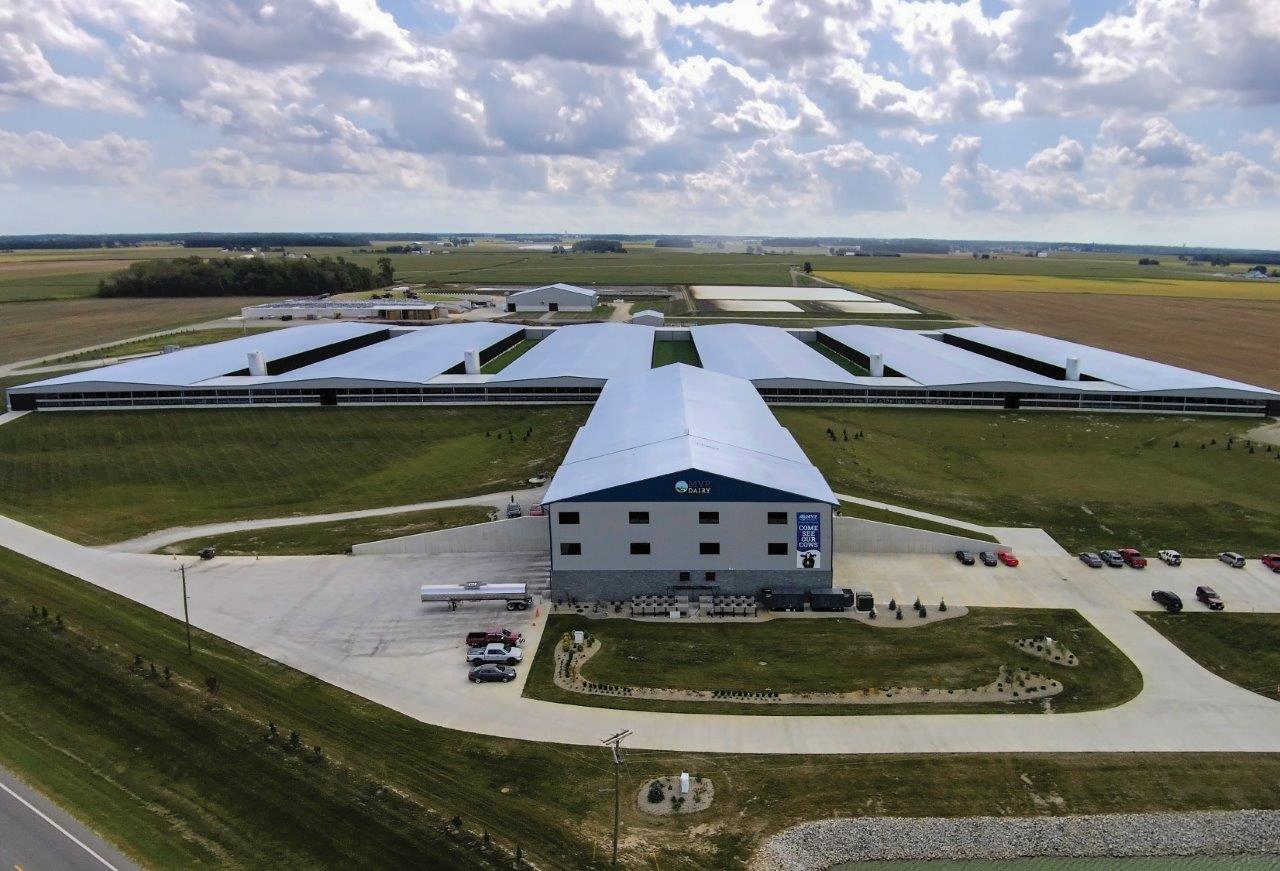
The business case for regenerative dairy
Regenerative farming practices can be environmentally beneficial, but some farmers struggle with making the business case to invest in the equipment and education needed to transform conventional operations into regenerative. Farmers have to take a long view, McCarty said.
“To put a [return on investment] on the deployment of regenerative agriculture practices, you have to measure in a long-term time scale,” he said. “Converting to no-till takes different equipment, and equipment is expensive. It takes time to grow that skill set.”
This can make it difficult to determine the financial success of certain practices in the short term, especially when business is in a down-cycle. "Agricultural margins are extremely thin and volatile," McCarty said. "If a farmer is focused heavily on survival, shifting gears to risky ventures like adopting a new method of running your farm and business can be a daunting task. Figuring out ways to de-risk those conversions is important."
However, there are some immediate financial benefits. For example, using composted manure solids in place of commercial fertilizers can offer savings, though the exact return on investment can vary year to year based on fertilizer prices and the amount that needs to be applied, McCarty said. Moreover, practices like integrating livestock into crop systems can introduce valuable micronutrients into the soil, boosting crop health.
McCarty is also optimistic about emerging markets for regenerative products, such as carbon credits, though he stresses the importance of integrity in these markets. “These marketplaces have to be done with integrity,” he said. “We as society can’t afford to slow down the pace of that progress because bad actors get involved and taint the integrity of those markets.”
Progress over perfection
Regenerative agriculture is not a silver bullet for the climate crisis, but McCarty believes that the incremental gains are important.
“Our dad always drilled into us that the one thing that is exciting about agriculture is that there is always something to work on, always something that we can improve upon and do better,” McCarty said. “We believe in progress over perfection, and regenerative agriculture is a part of that. It just so happens that this kind of improvement makes the world a better place too.”
The More Farmers Know About Agrivoltaics, the More They Like It
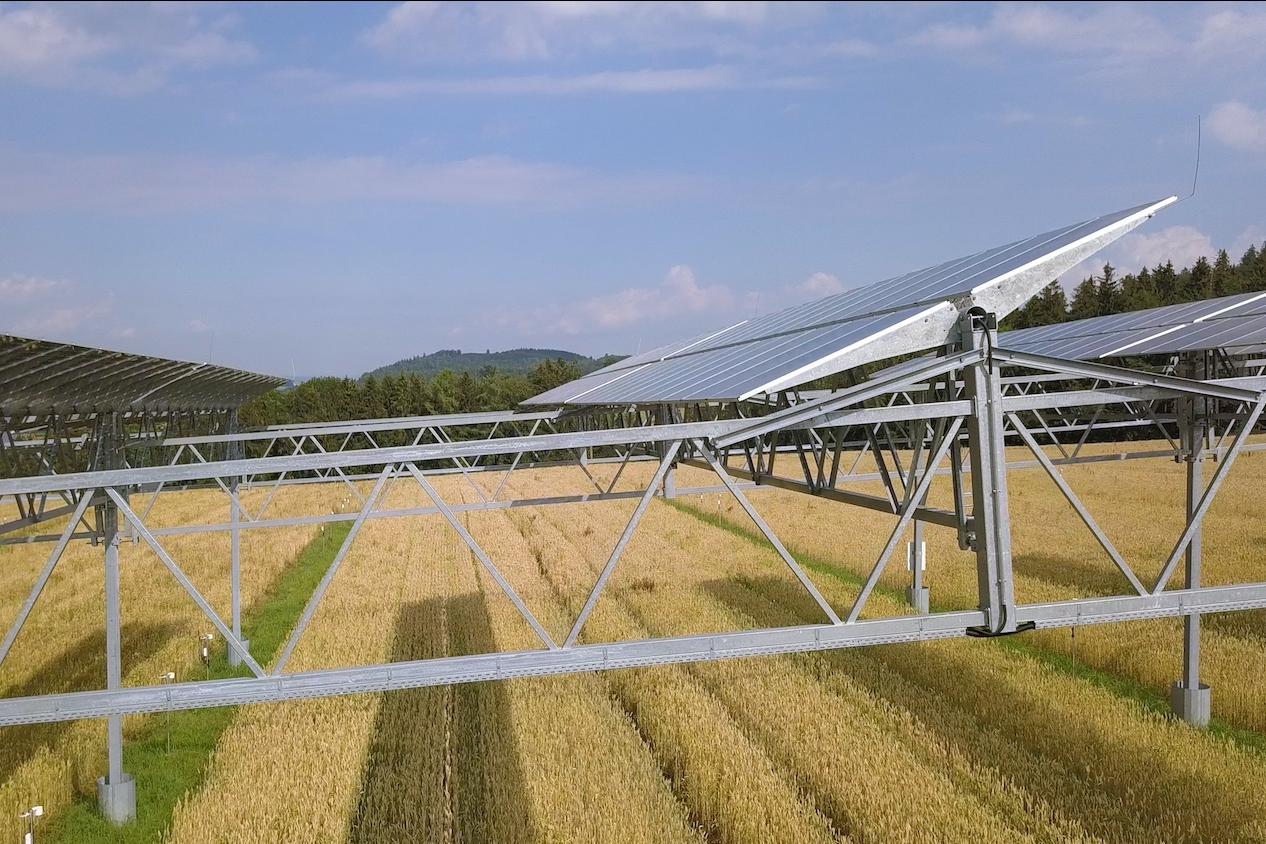
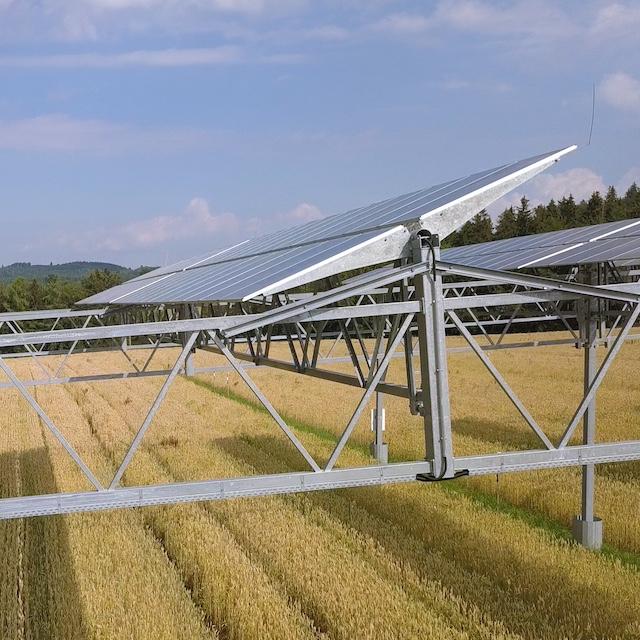
(Image: Tobi Kellner/Wikimedia Commons)
Until just a few years ago, utility-scale solar arrays were considered incompatible with farming. The situation is different today. Solar developers are learning how to design projects that enable farmers to continue working the land between solar panels. The idea is catching on quickly among farmers, too. Now the big question is whether or not the combination of solar panels with agriculture, called agrivoltaics, can scale up and become a significant force in the energy transition.
The agrivoltaic solution
Farmland offers multiple benefits to utility-scale solar developers, with utility-scale referring to large arrays of 10 megawatts or more. Farms consist of vast stretches of tree-less, sun-soaked terrain largely uncomplicated by habitat and biodiversity conservation issues. On their part, farmers were, and still are, attracted by the steady income from solar leases.
To reduce hardware costs, developers typically place solar panels close to the ground, which requires measures to keep vegetation from covering the panels. Some developers reseed the ground with low-lying plants like clover to reduce the cost of mowing and trimming. Others use sand or gravel to reduce or prevent undergrowth, in effect rendering the land permanently unsuitable for crops.
Reuters reporters P.J. Huffstutter and Christopher Walljasper described the destructive impact of using sand as a ground treatment on a farm in Indiana. They underscored the damage done by a ground treatment strategy focused solely on cutting costs.
The Indiana solar project was built in 2019, at a time when researchers were just beginning to assemble the agrivoltaic case. Since then, solar developers have begun to work with, not against, food systems and land conservation. An agrivoltaic array typically deploys taller racks to raise the solar panels higher off the ground, allowing farm activities to carry on.
Combining solar arrays with native plants and pollinator habitats for crop support or grasslands for grazing livestock are two of the earliest agrivoltaic practices to gain widespread currency. They still remain the most common examples, but researchers and farmers are beginning to experiment with human food crops that tolerate some degree of shade.
How to accelerate the agrivoltaics revolution
Although agrivoltaics is a relatively new science, word is spreading fast, raising the potential for rapid scale-up if certain hurdles can be overcome.
Information is one of the key missing pieces. A new survey from the Solar and Storage Industries Institute found that 30 percent of farmers were opposed to large scale solar development on farmland. But it also found that these same farmers were less likely to know about agrivoltaic solutions. That opens up the possibility for outreach and education to change minds.
The survey assessed that the overwhelming majority of farmers are already informed about agrivoltaics, finding that up to 70 percent of farmers approve of utility-scale solar arrays if they are based on agrivoltaic principles, which often reduce their concerns around farmland and solar development.
“The research shows most farmers are interested in exploring solar, provided that they have enough information to make good business decisions and continue farming,” David Gahl, executive director of the institute, said in a statement.
Meeting farmers where they're at
Improving access to information about agrivoltaics is not a one-size-fits-all solution. The survey identified another barrier in the form of race-based differences in farmer attitudes. The survey showed that farmers of color were less likely to approve of utility-scale solar projects. These same farmers were also less likely to be informed about agrivoltaic solutions, compared to their white counterparts.
“This finding suggests a need for a wide variety of trusted voices to help disseminate agrivoltaics information to communities,” according to the report.
The institute, which is the nonprofit educational branch of the trade organization Solar Energy Industries Association, notes that at least 30 percent of farmers surveyed trust the information they get from farm associations, extension services, universities and solar developers. That indicates that a more race-sensitive outreach campaign will encourage farmers of color to support agrivoltaic development.
Agrivoltaics, brand reputation and the bottom line
As the survey indicates, trusted solar developers can help strengthen the outreach and information network to enlist more farmers in support of utility-scale projects. But that depends on reaching a critical mass of developers experienced with agrivoltaics, and there is still a wide gap to fill. Most of the 600 or so agrivoltaic projects under way in the U.S. are relatively small, with less than 10 percent described as “large-scale,” according to the institute.
In consideration of the rising opposition to rural solar projects, the brand reputation factor could motivate more solar developers to avoid harmful, solar-exclusive development strategies and instead adopt agrivoltaic solutions, according to the institute.
“While developers are interested in pursuing farmland solar projects because they can be easy to develop in many respects, they are interested in pursuing agrivoltaic system designs because it preserves farmland and enhances the reputation of their company within the community,” according to the report.
The bottom line benefits to farmers are also emerging, as measured by land use efficiency. In Europe, where agrivoltiaic development is catching on more rapidly, researchers are already assembling evidence that the balance of crop yields with solar energy production is significantly more efficient when combined in one field.
Help is on the way
In the United States, additional support for the agrivoltaic movement is already in motion. The survey, for example, is the first step of a two-part program supported by the the U.S. Department of Energy in partnership with the Solar and Storage Industries Institute, the National Farmers Union, and the National Rural Electric Cooperative Association. The second phase will explore case studies.
As another indication of support, the conservation organization American Farmland Trust identified agrivoltaics as a pathway for protecting farmland from urban sprawl and other permanently destructive development.
Also contributing to the case for agrivoltaics is a new land use tool developed by researchers at the University of Wisconsin. The research team produced a first-of-its-kind map that identifies almost 30 million acres of previously cultivated land that has been abandoned since the 1980s.
There are still many knowledge gaps left to fill, but a new paradigm in the U.S. and global agriculture industry is taking shape, in which farmers and solar developers collaborate on clean energy and farmland conservation, too.
Can a Global Forest Network Equip Carbon Markets to Work for Our Planet?


(Image: Ken Shono/Unsplash)
One of the 19th century’s great scientific minds, William Thomson, better known as Lord Kelvin, famously said, “If you cannot measure it, you cannot improve it.” More than a century later, his maxim is being ignored, and as a result, the global community is failing to take all the steps necessary in the battle to reduce carbon emissions and prevent runaway global warming.
Most of the world’s governments and major companies are lining up to make carbon neutrality pledges and looking for ways to invest in carbon sequestration in order to remove this climate-warming gas from our atmosphere. Businesses are joining the effort, leaning into voluntary carbon markets and investing in projects that trap carbon as a way of offsetting the emissions they create elsewhere. And celebrities purchase carbon credits in an attempt to offset their carbon footprint as private jets whisk them from airport to airport.
But how do you actually pull carbon from the air and put it somewhere safe at a global scale?
There are two very large natural habitats that do this work: oceans and forests. Together, these habitats absorb over half of the excess emissions we produce each year. But today, we need to turn up the carbon-absorption capacity of these big carbon sinks. That is where forests have gotten a lot of attention because the way to make forests absorb more carbon is to grow trees. However, we have lost almost half the of the world’s forests already, and the majority of the remaining forests are not large mature forests. Instead, they’re a mixture of secondary or degraded forest. Meaning there is a lot of space globally for improving forests’ capacity to pull carbon from the air.
So why isn’t this happening all over the world? The answer, as Lord Kelvin would say, is measurement. Yes, nations spent billions to put satellite technology in place to monitor forests from space, but satellites cannot see carbon. And unless they are calibrated by measurements on the ground — the same measurements, made in all forest types, in all forest conditions, all over the world — they can’t measure carbon with the accuracy the world needs.
And because we have not invested in the fundamental nuts-and-bolts calibration — our “standard weight” for earth-observation satellites — we have essentially built a fantastic space-based solution to a global challenge and then failed to connect that solution to the problem it was built to solve.
The result is large-scale skepticism in the carbon markets. It is very hard to get excited about a market if you can’t keep track of the thing you are investing in, and it is very hard to agree on how many credits to award for a project if you can’t easily measure the carbon in the forest. Without a global, reliable system for the impartial measurement of forest carbon, no current or future participant in the process can be sure of what they are buying and selling, making it impossible for the market to achieve the viability and vitality needed to significantly offset carbon emissions. More perilously, without a rigorous, open system of measurement, it is difficult to track changes in the ability of forests to absorb carbon as climates change.
Today, that system is being built. It is called Geo-Trees, and it is a structure being built collaboratively by leading scientists at the Smithsonian, the European Space Agency, two of France’s research centers, the University of Leads, and leading scientists in Colombia, Brazil, the Philippines and Côte d’Ivoire. They’re working side-by-side with earth observation and forest-focused partners around the world.
The goal is to establish a global network of forest plots that cover all types and conditions of forest. In each of these plots, we will identify and measure all the trees, use drones and planes to get ultra-high-resolution imagery of each forest, use ground-based laser-scanning to create detailed maps of the architecture of each forest, and sample below-ground carbon biomass.
All of this data then "speaks" to satellites looking down on earth, creating a codex to interpret, enrich, calibrate, and translate real-time information from space into reliable measures of forest carbon — in any forest type, in any forest condition, anywhere in the world. This work on the ground is what is needed to accurately use satellites to measure carbon at the scale that landholders, investors and governments need.
This is a global initiative, supported by the Bezos Earth Fund, the Gordon and Betty Moore Foundation, the National Science Foundation, the European Space Agency and others. It’s connecting forest researchers from around the world, and linking a broad range of ground-based and space-based technologies to provide a globally accessible codex to carbon in the world’s forest.
The Geo-Trees network is starting in the tropics, the most carbon-rich forests in the world, and establishing research sites across the world. In the coming years, the program will extend to all forests, providing hundreds of monitoring sites where satellite-based measurements of forests can be combined with detailed information on tree identity, wood density, tree architecture and soil carbon.
Upon completion, the measurement of carbon in a particular forest, and the impact of human actions on that carbon, will be almost as seamless and simple as measuring the weight of your apples when leaving the store. You don’t worry about the quality of the scale at the check-out counter because the scale has been calibrated. This is the foundation needed to support and reward actions that pull carbon out of the air and put it in trees all over the world.
Far more important than his rhetoric, Lord Kelvin devised the scale that established absolute zero, which became an international standard for temperatures that still bears his name. He should serve as a reminder of, and an inspiration for, the work we still need to do to establish a measurement to contain the damage of carbon emissions.
Tony the Tiger is Keeping U.S. Middle-Schoolers Engaged in Sports
(Image courtesy of WK Kellogg Co.)
What do Simone Biles, Michael Phelps and Shaquille O’Neal all have in common?
Olympic gold medals? Not quite. They all won Olympic gold, but O’Neal threw his medal out the window driving home from the 1996 Olympic Games in Atlanta, Georgia.
The answer we were looking for is that they’ve all been featured on a box of Kellogg’s cereal.
One of the things that got those athletes to the pinnacle of their sports was the support they received throughout their youth, be it from their parents, community leaders, sports organizations or schools.
Unfortunately, not every child or young teen has access to those support systems. That’s why WK Kellogg Co. started its Mission Tiger program five years ago to fund middle school sports programs. Since 2019, the Mission Tiger program has donated over $4 million across more than 3,000 schools in all 50 states.
Doing good, and doing good for business
“We really believe that in order to withstand the test of time as a company, we need to do initiatives like Mission Tiger that do good and do good for business,” said Sarah Ludmer, chief wellbeing and sustainable business officer at WK Kellogg Co. “We can’t just make good, delicious food anymore and that be our only business approach. We know consumers expect more.”
Consumers do make purchase decisions based on a brand’s environmental and social sustainability efforts, according to an analysis by the research technology firm Glow, in partnership with TriplePundit, our parent company 3BL and panel partner Cint. The effect of consumers switching brands for sustainability reasons in the U.S. alone amounts to $44 billion annually.
When deciding on which initiative to invest time and resources in, the Frosted Flakes cereal mascot Tony the Tiger’s history of promoting youth sports made the choice clear.
“We found that middle school is the biggest time when youth are dropping out of sports,” Ludmer said. “Knowing Tony and knowing he’s always been for activity and helping kids, we just felt like this was the right fit for us.”
The program has provided 2 million "sports experiences" for youth, defined as anything the program does to help students play sports and the number of students it affects, from providing uniforms to field maintenance and everything in between.

Without partners, there is no Mission Tiger
The Mission Tiger program could not be managed without its partners. The company leans on the help of four important partners to bring its youth sport engagement objectives to life.
The Aspen Institute is Mission Tiger’s research partner. It identified the gap in middle school sports and found that youth in sports do better in school and have better social acumen.
DonorsChoose is the nonprofit partner that identifies the schools in need, allowing donations to be delivered directly.
Retail stores that sell Kellogg’s cereal are also major partners. “Whether it’s Walmart, or Meijer, or name your local retailer, they’re on a similar journey to identify programs that can reach their communities,” Ludmer said.
And the customer plays a pivotal role in the program. By purchasing Kellogg’s cereal, then uploading their receipt online, consumers trigger a $3 donation to the Mission Tiger program.
“This goes back to that doing good and doing good for business as well,” Ludmer said. “It’s one thing for a brand to tell a consumer this is what we're doing. It's another to say, ‘Hey, this is a big problem. Will you come help us solve it?’”
How can other organizations build a similar program?
“It’s super important to find programs that matter to the brand, matter to the consumer and help your retailer,” Ludmer said.
Many business-driven purpose programs, like Mission Tiger, so often fail because they become more of an add-on to the budget than a return on investment, she said. Without the business benefits, support for the project could easily fade. WK Kellogg Co. is seeing a return on its investment.
“The awareness and brand equity that we’ve seen through this, that’s one thing,” Ludmer said. “We've also seen customer response to be extremely strong because they love having community events and it gives them a way to give back — both of those from a business standpoint are beneficial for us. And then on top of that, it makes our people happy, and there's no better value or return on investment than your employees being proud of the work that your brands are doing.”
Is Kellogg’s cereal a healthy choice for youth?
“100 percent yes,” Ludmer, a dietician by trade. “I’ll be honest, cereal gets a bad rep, but it’s the number one source of whole grain and fiber that exists in the American diet.”
And the added sugar? It depends on the type of cereal, but on average, “cereal contributes less than 5 percent of the added sugar in the American diet,” Ludmer said. “The other piece to remember with this too, is it's the first meal that a kid actually makes on their own. It drives a choice level and that's super empowering for a kid.”
Empowering kids is what Kellogg’s and Tony the Tiger are known for, and who knows, one of those kids might just feature on a box of Frosted Flakes with the Olympic rings one day.
How Brands Can Rewire Consumer Behavior Away From Single-Use


(Image: myboys.me/Adobe Stock)
For years, the business of consumer packaged goods was built around the core principles of production and rapid, single-use consumption. Success was measured around the demand and use that businesses can encourage — and the profit this generates.
It's now become clear that this model had a huge impact on the planet, leading to irresponsible consumption. So, when it comes to sustainability, these businesses now have a crucial part to play and a responsibility to reverse this behavior.
Research has repeatedly shown that consumers view brands as equally accountable — if not more so — than governments in driving responsible consumption. According to a recent Nielsen IQ survey, for example, 46 percent look to brands to take the lead on creating sustainable change.
Consumer packaged goods companies (CPGs) need to recognize and embrace that significant change will only happen if they help lead the way.
Balancing consumption drivers
The challenge is that driving responsible consumption is push and pull. On the one hand, it’s about changing what consumers expect and will accept by using innovation to answer those evolving needs. Promises of low cost and high performance will always be a priority for consumers, so it’s up to brands to show consumers that sustainable consumption doesn’t have to mean a compromise on those key drivers.
But equally important is the realization that behavior has evolved to the point of consumers expecting and seeking instant gratification — the quick hit of dopamine that comes with so many fast-moving goods. People are buying into experiences and feelings with every single-use purchase. So, alongside making the sustainable choice convenient and cost-effective and addressing functional requirements, brands need to address this and rewire what satisfaction looks like.
Fashion sites like Vinted and Vestiaire Collective have taken some great strides here. As fashion resale sites, they have made the thrill of the sustainable chase exciting and turned it into strong social currency.
CPGs need to do the same. It’s arguably harder with a cleaning product or bottled water to land on what that thrill could look like. Method was an early example of a brand recognizing that the sustainable option could offer the style and cultural cachet worthy of a social media grid. While sustainability metrics have moved on since then, the brand still shows how a conventional, functional or even ‘boring’ category can change the game.
A more recent example is Evian launching its (Re)new product, a refillable water dispenser bringing Evian natural mineral water into the home using 60 percent less plastic packaging, back in 2021. Developed and launched with the late Virgil Abloh as creative advisor, it marked an ambitious step in the brand’s move away from single-use bottles.
Uncovering the secondary benefits
This is where brands can have significant impact. If sustainability goals force them to explore new product and pack experiences, why not look at the whole consumer journey to revolutionize behavior? Through this process, they can potentially identify other pain points, where the solution goes hand-in-hand with the more sustainable option. It’s such a golden chance to rethink engagement and interaction — and influence consumption for the better.
Take concentrated toothpaste tablets for example, such as Smyle or Pärla. They were driven by the need to eliminate the transport of excess liquid around the world, which is also needed in the formulation of conventional toothpaste, but they have the added benefit of being more portable. Who walks around with a tube of toothpaste in their clutch bag? Taking two tablets on the go is much more convenient.
Suddenly, in your drive for sustainability, you can meet an unmet need and deliver a secondary benefit to really encourage a shift.
Shifting the single-use mindset
The key is to realize and embrace that the single-use mindset can only take you so far in an age where more and more legislation against it is on the horizon. In France, for example, supermarkets are being forced to address single-use plastic. By 2030, 20 percent of their floor space will need to be dedicated to refill systems. But there are so many companies that are still not doing enough on reuse, reduce and return. Startups often lead the way, with refill deodorants, direct-to-consumer subscription toilet paper and refillable cleaning products. Large global players need to keep up.
In addition to addressing the single-use mindset, companies need to invest in wider sustainability drives. Take inspiration from Patagonia’s repair centers across the world, U.K. retailer M&S following suit with its own clothing repair services, or Nestlé investing in a new plastic recycling plant in the U.K.
Looking at services that support more sustainable consumer behavior is just as important as product innovation. This goes right down to thinking about last-mile logistics to help your products travel shorter distances and encouraging a more decentralized and bespoke approach to sustainable solutions.
Ultimately, brands need to realize that the call for sustainability isn’t just another trend. It’s an imperative. It must be brand and government led; we cannot afford to wait for it to become fully consumer led. Moreover, it requires radical changes. With innovation, brands often want to start small to see how much traction an idea will gain. But the time for viewing sustainability as a niche part of your innovation pipeline is over. It must become the fundamental tenet your brand is built around.
Older Employees Could Be the Answer to Tech's Workforce Problem


(Image: insta_photos/Adobe Stock)
Layoffs by major tech companies may attract headlines, but they obscure the true picture. The demand for tech talent, particularly at the entry level, continues to grow. As the digitization of the global economy continues, almost every company is arguably becoming a tech company in some way.
Companies across various industries — including healthcare, retail and manufacturing — are expanding their workforces with a diverse range of roles. Tech employment in the European Union increased by 5 percent every year from 2010 to 2019, according to the International Labor Organization. In the United States, tech employment rose at a yearly rate of 3.3 percent from 2011 to 2021, according to the U.S. Bureau of Labor Statistics. That’s almost 10 times the growth rate of general employment in the country.
As tech companies wrestle to meet the demand for workers, a source of talent is not being tapped as much as it could be: older workers, according to a report by the global economic mobility nonprofit network Generation.
The report is based on a survey of more than 5,200 job seekers, tech employees, and tech and non-tech employers in eight countries: Brazil, Canada, France, Germany, India, Mexico, the United Kingdom and the United States. The key takeaway from the survey: Employers should radically rethink how they recruit talent for entry-level tech positions.
Of the employers surveyed, 86 percent are hiring entry-level tech employees, Mona Mourshed, Generation CEO, told TriplePundit. And 62 percent are investing in initiatives such as onboarding, mentorship, and internship programs to expand and diversify entry-level talent pools and boost profitability.
Nevertheless, more than half of employers are running into difficulties sourcing entry-level talent. And even more of them agree that the recruitment processes for these roles need to change.
“Only about half of companies actually consider age to be part of diversity, equity and inclusion, so it is often overlooked,” Mourshed said.
Despite the lack of consideration for age, more people are working later in life. So businesses will increasingly depend on workers aged 60 and above, according to the Organization for Economic Co-operation and Development.
“We observe that in green jobs and in healthcare, employers have greater appreciation of mid-career and older workers,” Mourshed said. “It tends to be tougher in the tech arena because of the perception that people who are in their 40s, 50s, etcetera, won’t be as comfortable with technology, they won’t learn as much, they won’t learn as fast, they will struggle with change and so on.”
The perception these companies hold is that people in their 30s are in a “Goldilocks zone” with just the right amount of work experience and maturity and are still able to learn, she said.
“When we asked companies whether they felt that the mid-career older candidates that they were getting were fit for their purposes, only 15 percent said yes,” Mourshed said. “But when we asked those same companies how the mid-career and older workers they hired are doing on the job, 86 percent said they are doing as well, if not better, than their younger peers.”
Generation, which provides programs to prepare workers of all ages for the emerging job market, specifically forms mixed age cohorts in its training programs, she said.
“We seek to have younger learners and our mid-career and older learners paired up and actively learning from each other because the best workplaces are indeed intergenerational,” Mourshed said. “The best companies in the world are very creative about how and where they find talent, and this is a vibrant pool of talent.”
Governments can play a crucial role in encouraging companies to hire older workers, she said. Funding for work training tends to be geared towards younger individuals.
Singapore, for example, has programs that support training for mid-career and older workers to start new careers and be placed in a new job, she said. The government also jointly pays the salary of those mid-career and older workers for the first year of their new jobs.
“From the employer’s perspective,” Mourshed said. “This helps to mitigate the risk of hiring someone with a work profile that is different from what they would usually hire.”
Every Mention of Climate and Environment From the U.S. Presidential Debate


As the U.S. prepares to head to the polls in November, presidential candidates Kamala Harris and Donald Trump met for their first debate at the National Constitution Center in Philadelphia this week. (Image: rawpixel.com/Adobe Stock)
U.S. Vice President Kamala Harris and former U.S. President Donald Trump faced each other on the debate stage for the first time in Philadelphia last night. During the 90-minute session hosted by ABC News, the opposing presidential candidates squared off on key issues of importance to the American public, including the rising cost of living, reproductive rights and election integrity. Read on for every time they mentioned climate change and environmental issues, along with fact-checks and commentary from the TriplePundit news desk.
Moderators asked only one question about climate and environment during the presidential debate
The topic of climate change was only posed once in the presidential debate. While this may come as disappointing to some voters, it's fairly consistent with mainstream media coverage of climate change in the U.S. The major U.S. television networks — ABC, CBS, NBC and Fox — devoted less than 1 percent of their airtime to discussing climate change in 2023, according to the nonprofit Media Matters for America. Toward the end of the 90-minute time slot, ABC News anchor Linsey Davis addressed the candidates with the following:
“We have another issue that we'd like to get to that's important for a number of Americans, in particular younger voters, and that's climate change. President Trump, with regard to the environment, you say that we have to have clean air and clean water. Vice President Harris, you call climate change an existential threat. The question to you both tonight is what would you do to fight climate change?”
Vice President Harris had this to say in response:
“The former president had said that climate change is a hoax. And what we know is that it is very real. You ask anyone who lives in a state who has experienced these extreme weather occurrences who now is either being denied home insurance or is being jacked up. You ask anybody who has been the victim of what that means in terms of losing their home, having nowhere to go. We know that we can actually deal with this issue. The young people of America care deeply about this issue. And I am proud that as vice president over the last four years, we have invested a trillion dollars in a clean energy economy while we have also increased domestic gas production to historic levels.
"We have created over 800,000 new manufacturing jobs while I have been vice president. We have invested in clean energy to the point that we are opening up factories around the world. Donald Trump said he was going to create manufacturing jobs. He lost manufacturing jobs. And I'm also proud to have the endorsement of the United Auto Workers and Shawn Fain, who also know that part of building a clean energy economy includes investing in American-made products, American automobiles. It includes growing what we can do around American manufacturing and opening up auto plants, not closing them like what happened under Donald Trump.”
The former president did not mention climate change or the environment in his response, spending the one-minute allotted time criticizing the Biden-Harris administration's record on manufacturing jobs.
Our take: The framing of the question itself is noteworthy. While polling shows that young voters are the most likely to list climate change as a top issue, research shows it is important to voters across demographics. Even as the cost of living crisis looms large, more than a third of Americans list climate change as a top-three issue facing society, including 38 percent of baby boomers, according to research released by TriplePundit this summer. A report published by Deloitte this week also indicates it's a top-three issue for the majority of C-suite executives.
Despite voter concerns, Donald Trump did not take the opportunity to dispute or amend his 2016 statement that climate change is a hoax invented by the Chinese government. More recently, he said rising global temperatures would come with the benefit of "more oceanfront property."
Harris, on the other hand, directly referenced the impact that climate change already has on the American public. In the first eight months of 2024 alone, the U.S. experienced 20 weather and climate events with losses greater than $1 billion each, according to the U.S. National Centers of Environmental Information. Each of these events represents thousands of people whose homes were damaged or lost, and whose towns now face months or years of reconstruction.
The trillion dollars in clean energy investment Harris mentioned likely refers to provisions included in the Inflation Reduction Act and Bipartisan Infrastructure Law. While environmental groups have called them "the most ambitious environmental laws in U.S. history," fact-checkers at outlets including Atmos.Earth observe they don't add up to a trillion dollars in investment. That said, a key goal of the legislation is to stimulate private investments in clean energy that go above and beyond direct funding from the federal government, and it is unclear if Harris included private capital in her trillion-dollar total. It is also true that domestic U.S. production of oil and gas set new seasonal records in 2023, though overall greenhouse gas emissions tied to energy fell by about 7 percent.
Trump calls clean energy into question
While climate was only mentioned once, the U.S. energy system came up a number of times across the debate that are worth noting. In particular, former President Trump made some outlandish claims about the viability of clean energy, including:
“If [Harris] won the election, the day after that election, they'll go back to destroying our country and oil will be dead, fossil fuel will be dead. We'll go back to windmills and we'll go back to solar, where they need a whole desert to get some energy to come out. You ever see a solar plant? By the way, I'm a big fan of solar. But they take 400, 500 acres of desert soil. These are not good things for the environment that she understands.”
He later addressed Harris with the following:
"[Y]ou believe in things that the American people don't believe in. You believe in things like we're not going to frack. We're not going to take fossil fuel. We're not going to do things that are going to make this country strong, whether you like it or not. Germany tried that and within one year they were back to building normal energy plants. We're not ready for it. We can't sacrifice our country for the sake of bad vision."
Our take: There's a lot to unpack here. For starters, what is a "normal" energy plant anyway? A hundred years ago, a normal energy plant would have been powered by coal, but because coal is now the most expensive source of energy in the U.S., the use of coal power continues to decline. In short: Things change, which is why you'll rarely hear expert professionals using words like "normal" to describe matters of consequence to public life.
Similarly, the notion that the U.S., and the world more broadly, are "not ready" to source energy from renewables is not supported by data. Generating energy from solar and wind is now cheaper than oil and gas in most scenarios, and investment in renewables is set to double investment in fossil fuels globally this year. Germany in particular is a clean energy leader, supplying more than half of its power needs with renewable energy in 2023. (To be abundantly clear, Germany plans to continue to expand its use of renewable energy, but it did stop using nuclear energy last year.) In the U.S., zero-carbon sources made up over 40 percent of the energy mix in 2023.
Also worth noting: While the land footprint of renewables remains a challenge, most solar farms are far less than 500 acres in size, and advancements in both solar and green hydrogen technologies allow new projects to create more energy on less land.
Fracking emerged as a major topic of conversation, but do Pennsylvanians really care?
With the debate located in Pennsylvania, a key swing state where the candidates are polling neck and neck, the topic of fracking was mentioned more than twice as many times as climate change. Trump aimed to put the vice president on the defensive for her previous calls to ban fracking, saying: “Fracking? She's been against it for 12 years.”
Harris moved to clarify her position, saying she no longer supports a fracking ban:
"I made that very clear in 2020. I will not ban fracking. I have not banned fracking as Vice President of the United States. And, in fact, I was the tie-breaking vote on the Inflation Reduction Act, which opened new leases for fracking. My position is that we have got to invest in diverse sources of energy so we reduce our reliance on foreign oil. We have had the largest increase in domestic oil production in history because of an approach that recognizes that we cannot over rely on foreign oil."
Our take: It's true the Biden-Harris administration made no attempt to ban fracking. At the same time, the very notion that fracking — short for hydraulic fracturing, a method of extracting oil and gas by injecting a chemical solution into the earth — is popular enough in Pennsylvania to warrant multiples mentions across the debate is questionable.
While the state makes a lot of money from fracking, environmental groups say the claims around jobs are overstated, and no research shows that Pennsylvanians are in universal agreement on the practice being of benefit to them and their communities.
"Here’s the truth from someone who actually lives in Pennsylvania. Most folks, especially in areas like Philadelphia, Pittsburgh, and their suburbs where many voters reside, don’t really talk about fracking — certainly not as much as the big issues like the economy or abortion rights," longtime Philadelphia Inquirer columnist Will Bunch observed last week. (As a Pennsylvanian myself, I agree.) Bunch cited polls that range from 30 percent to 50 percent support for fracking across the Keystone State and referenced financial data that indicates fracked gas has only economically benefits one or two of the state's 67 counties.
The bottom line
For voters who consider climate change and the environment as they head to the polls, Trump didn't give them much to go on beyond continued support for fossil fuels. Major environmental groups including the League of Conservation Voters Action Fund, the Natural Resources Defense Council Action Fund, the Sierra Club and Clean Energy for American Action have already endorsed Harris for president, citing a long track record of support for reducing emissions and pollution.
“Whether holding polluters accountable as San Francisco District Attorney and California Attorney General, leading the charge on electric school buses in the U.S. Senate, or casting the deciding vote on the biggest investment ever in climate, clean energy and environmental justice and leading on climate on the world stage as Vice President, Kamala Harris has long been a climate champion,” Tiernan Sittenfeld, senior vice president of government affairs for the League of Conservation Voters Action Fund, said in a statement endorsing Harris.
What is your take on the candidates' environmental records, and what stood out most to you during the first presidential debate? Tell us about it here.
The Numbers Prove That Plastic Bag Bans Work


(Image: whitcomberd/Adobe Stock)
A new report from the Ocean Conservancy connects recently enacted statewide plastic bag bans to a significant drop in the number of plastic grocery bags cleaned up from beaches. The noticeable impact of law-making is a sharp contrast to the many years of effort spent urging individuals to voluntarily bring reusable bags when shopping.
Building support for plastic bag bans
In addition to providing data-driven support for new legislation, the Ocean Conservancy report also validates efforts from the business community to raise public awareness about plastic pollution, including manufacturers as well as public-facing industries like travel, fashion, sports and beverages. Even the music industry is beginning to take much-needed action to curb plastic waste.
The challenge, though, is to translate individual feelings into concrete action steps. After all, a volunteer beach cleanup does nothing to prevent the next wave of plastic litter. But awareness-raising and volunteer activities can help to build voter support for impactful legislation.
In the report, Conservancy scientists note that statewide plastic grocery bag bans covered only 12 percent of the U.S. population in 2020. Since then, new legislation has more than doubled that figure. Eleven states now have statewide bans, covering 25 percent of the U.S. population. Hundreds of municipal governments have also banned plastic bags, according to the report.
The research measures the impact of bag bans by tracking the number of bags collected by the Conservancy’s International Coastal Cleanup volunteers. Leaving aside a temporary surge in 2020 attributed to the COVID-19 pandemic, the results were spectacular.
Compared to the baseline years of 2013 through 2019, the volunteers collected 29 percent fewer bags in the 2022 and 2023 cleanup season, an achievement that the Ocean Conservancy directly attributes to new statewide legislation.
Public awareness works
The overarching message of the new report is that businesses can make a difference by continuing to build public awareness about ocean plastic pollution. That includes sponsoring volunteer activities, with the crucial step of collecting data and coordinating with data-driven conservation organizations like the Ocean Conservancy to measure what is collected over time.
Volunteers with the Conservancy's International Coastal Cleanup track their collected debris on the organization’s Clean Swell app or by hand. The totals go into a database kept by the Conservancy. “This database is the world’s largest repository of marine debris data and is used to inform scientists, conservation groups, governments, and industry leaders about ocean trash in support of plastic pollution prevention and advocacy efforts,” the Conservancy explained in its recent report.
The database contributed to new legislation in California and Florida in 2022, 2023, and 2024, covering balloon releases and foam products as well as plastic bags, the Conservancy reported. The data also informs the organization’s advocacy for an international plastic treaty.
Making a difference: The bipartisan infrastructure law and local economic impacts
Voter support can also make a crucial difference in other areas of ocean plastic remediation and prevention, as illustrated by a new funding recommendation of $5.2 million for the Conservancy funded through the 2021 bipartisan infrastructure law. The law passed with a Democratic majority in the Senate and skimmed through the Republican-lead House of Representatives with 13 Republican lawmakers tipping the balance.
The award is just one part of a $47 million carveout in the legislation for the Marine Debris Program of the National Oceanic and Atmospheric Administration, aimed at removing bulky marine debris.
Announced last week, the four-year Conservancy grant will focus on a variety of bulk waste including derelict fishing nets and large balls of discarded fishing gear, often called “ghost gear.” Though the Ocean Conservancy lists plastic bags among the top five most commonly found items on beaches, ghost gear poses a far more widespread threat to marine life. However, unlike beach litter, ghost gear is often found drifting or entangled out of public view.
“Ghost gear — much of which is made of plastic — is the most harmful type of debris for marine animals, and all large marine debris threatens marine life and sensitive ecosystems,” the Ocean Conservancy noted in a press announcement about funding. "This grant will allow us to go to remote locations heavily impacted by debris and deploy specialized equipment to remove items too large to remove by hand," Allison Schutes, the organization's senior director of conservation cleanups, added in a statement.
The economic case for reducing ocean plastic waste
Once the award receives final approval, the Conservancy will work with local stakeholders in Alaska, California, and Florida to remove ghost gear and other items in remote locations that require special equipment and training to access.
“Marine debris is not just a threat to marine life; it endangers the livelihoods and cultural practices of Indigenous communities who have stewarded these Arctic waters for millennia,” Barbara ‘Wáahlaal Gidaag Blake, the Conservancy’s VP of Arctic conservation, said in a statement. Ms. Blake is a member of the Káat nay-st/Yahkw Jáanaas (Shark House/Middle Town People) Clan in Alaska, where the Conservancy coordinates cleanup efforts with local tribes.
“The Arctic is a critical region for global biodiversity and plays a vital role in regulating our planet’s climate,” Blake said. “This funding from NOAA supports our collaboration with local tribes to remove this harmful debris, protect these essential ecosystems, and ensure the resilience of communities that are key to maintaining the health of our planet.”
Local stakeholders are also front and center in California, where the Conservancy will focus on helping lobster fishers in the Santa Barbara Channel and Channel Islands implement best practices to reduce ghost gear. The funds will also cover commercial fishers in the Port of Los Angeles. Similarly, the Conservancy will work with local organizations in Florida, where its director of Florida conservation, Jon Paul Brooker, takes note of “a powerful appetite” among anglers and other stakeholders to take meaningful action to reduce plastic pollution off their shores.
The voices of local economic stakeholders can become a powerful new force in support of new legislation aimed at cutting off the ocean plastic problem at the source. As demonstrated by the increasing number of U.S. states banning plastic bags, business leaders can keep the momentum by continuing to ensure the ocean plastic issue is top of mind in the public conversation.
How Kore Infrastructure Plans to Reduce Wildfire Risk by Turning Waste Into Energy
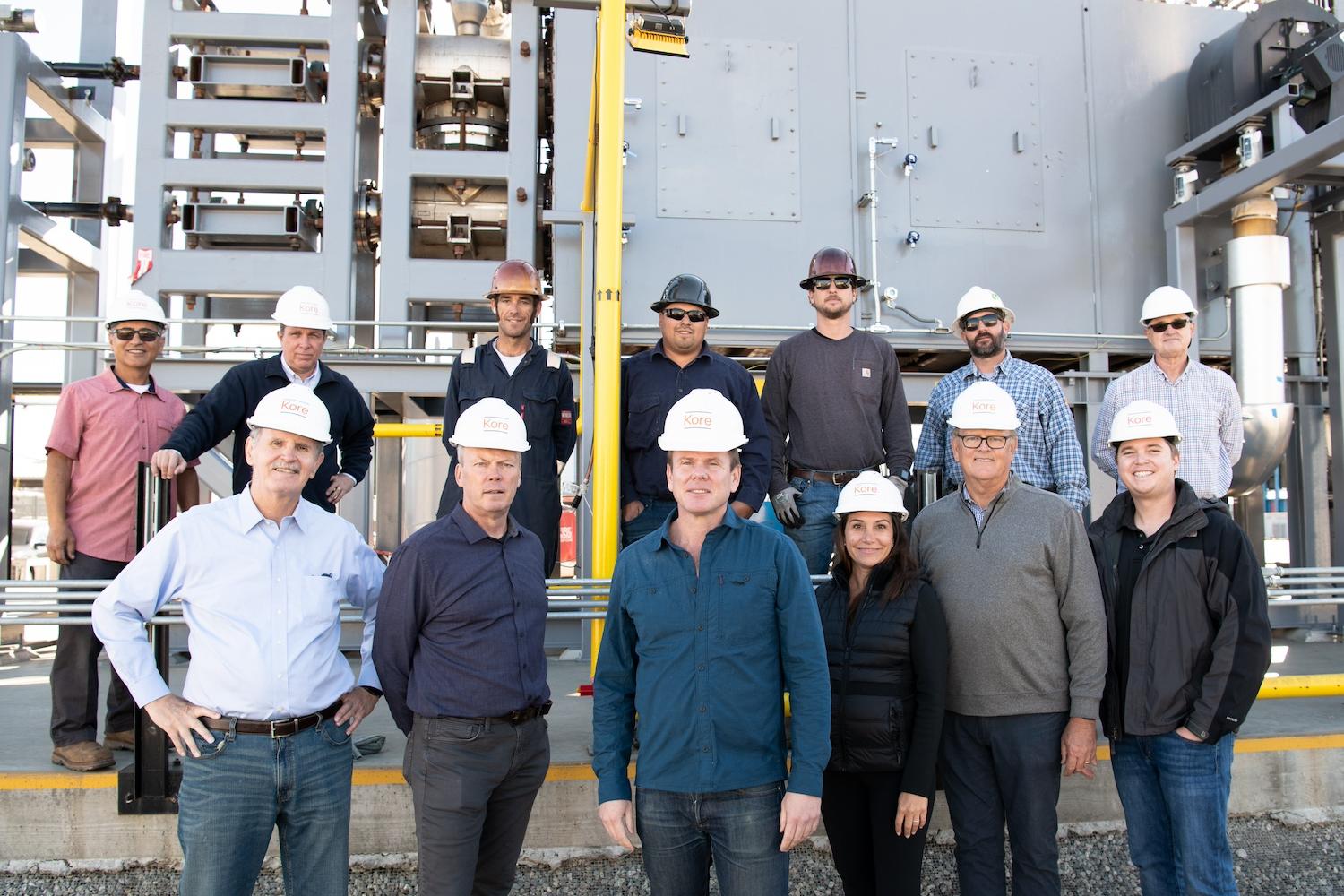
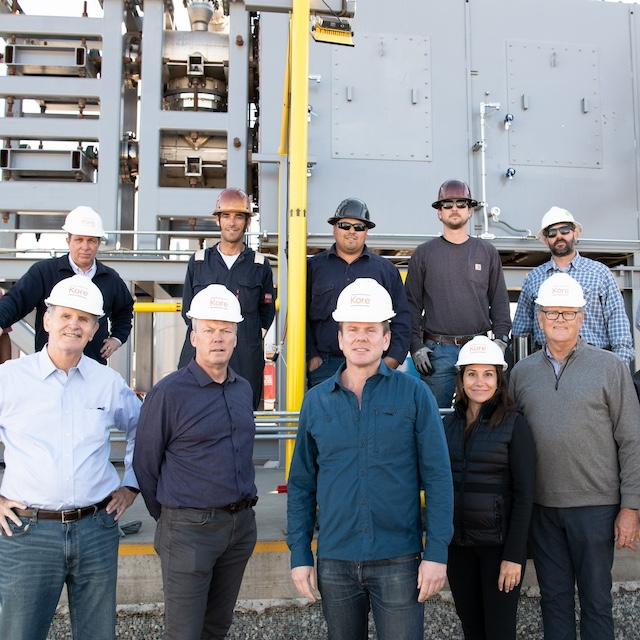
The Kore Infrastructure team. (Image courtesy of Kore Infrastructure.)
Could producing clean energy for the artificial intelligence (AI) boom also reduce wildfires? Kore Infrastructure’s founder and CEO, Cornelius Shields, hopes so. “Everyone wants to talk about AI [and] where's the power coming from,” he said. “We can play a part.”
Kore’s high-heat pyrolysis process converts biomass — such as agricultural prunings, nut shells and organic waste — into carbon-negative hydrogen, renewable natural gas and biogas. It keeps biomass out of waste streams while producing energy in a closed-loop system that powers itself. And by using dead, dying and diseased trees as feedstock, it could have the added preventative benefit of reducing wildfire risk.
Pyrolysis proving grounds
“Nobody wants to take a risk on something new until it's fully proven,” Shields said. “I think that's what it really takes to succeed. To bring in new energy, new infrastructure, you have to really be patient. You can't rush it to market.”
In 2022, Kore partnered with the Southern California Gas Company to produce clean fuel from organic waste to demonstrate how that energy could be made available to industries that are not easily electrified, specifically transportation. The project spared landfills 24 tons of trash every day it was in operation.
Shields credits some of the project’s success to Kore’s modular system. Instead of building a massive complex, the pyrolysis plants fit on just an acre, drastically reducing the cost of operation. That small size also makes the modular plants ideal for forest settings, where he’s eager to demonstrate that removing deadwood for processing can have a positive impact on wildfire prevention.
Converting wildfire fuel to energy
Kore is testing that theory in partnership with the Tule River Tribe in California, where tribe members are removing brush and deadwood near power lines. Left as is, all of that tinder creates an enormous wildfire risk. The 2018 fires in Paradise, California, began when downed power lines set the nearby national forest ablaze.
“There is evidence to support, based on controlled burns and others, that managing forests is not only healthy for the forest, but it does mitigate wildfires,” Shields said. ”In layman's terms, there's just less fuel … I truly believe that, once we get some early proof statements, integrating a technology like Kore’s into forest management will become a regular and known, established practice.”
Stepping in where there’s too much fuel for prescribed burns
Between irresponsible logging methods, the suppression of natural fires and overgrazing by livestock, North American forests have suffered mismanagement under the U.S. and Canadian governments’ tutelage. One way authorities tried to course-correct this is by intentionally setting controlled fires, which they call prescribed burns. Indigenous people have used intentional, controlled cultural burns for many millennia to manage the land, but federal and state fire suppression regulations have long prohibited and hindered the practice. However, due to the scale of the problem now, these burns often can’t be the only solution.
“With some of the factors that exist in forests, like dense areas of trees that have limited moisture, there's so much fuel,” Shields said. That makes burns more difficult to control.
There’s also the matter of how much carbon could be released at a time when the planet is already choking on our excess. “Pyrolysis is a non-incineration technology,” he said. “The emissions profile from a non-combustion process is far superior.”
In addition to producing clean energy out of potential wildfire fuel, pyrolysis also results in a substance known as biochar. Biochar is nutrient-dense and can be used in regenerative agriculture or reapplied to the forest floor to restore the soil in the same way that allowing deadwood to decay does, Shields said.
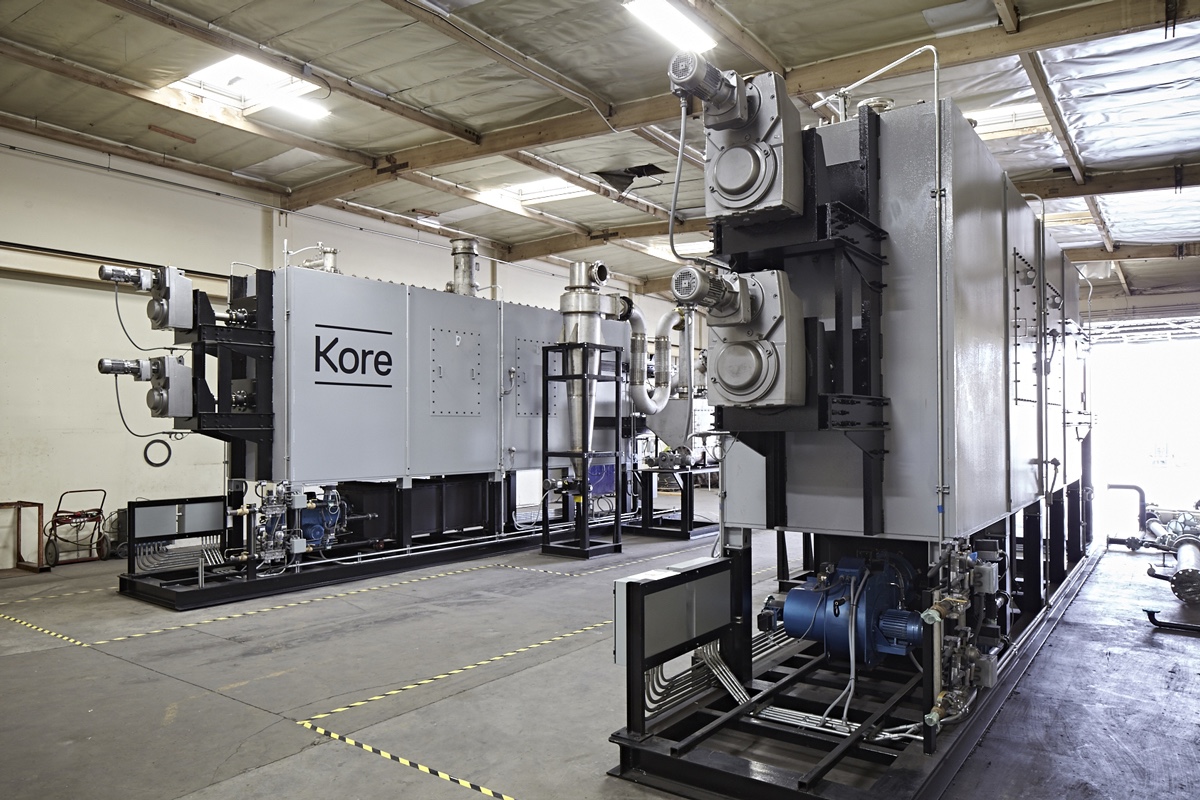
One potential pitfall stands out
Scaling the use of deadwood for conversion to clean energy doesn’t come without risk. While Kore handles the production of clean energy and biochar through pyrolysis, the inputs are provided by contractors. This leaves the harvesting side open to abuse by those entities.
“I think there's potentially a shadow side of it, as well,” Shields said. “Most of these contracts to manage the forest go to paper companies and logging companies. And you hope that they choose the dead and decaying ones, right? That's what we want to make sure [of], and that it's not an opportunity for them to … take other trees.”
Clear-cutting healthy trees, or including them in the feedstock, in the name of profit could override the benefits of forest-based pyrolysis. “Those that have the best interests of the natural world at heart, they have to have a seat at the table to make sure that doesn’t happen,” he said.
Partnerships with Indigenous communities, such as Kore’s collaboration with the Tule River Tribe, are therefore ideal. But the company is not able to control who forest management contracts are given to.
AI’s appetite for energy could spur clean energy tech
With data centers expected to require 160 percent more electricity in 2030 than they do today, the AI boom is threatening to cause a surge in energy use. Without enough clean energy options, this will likely lead to an increased reliance on fossil fuels, undermining global goals for decarbonization.
But Shields is optimistic that the tech industry will be a boon for carbon negative options like pyrolysis. “Their search for clean energy for AI, which is a fascinating turn of events, I think will actually accelerate technological solutions,” he said.
As such a solution, pyrolysis comes with the added benefits of keeping waste out of landfills and potentially protecting forests from wildfires. And unlike wind and solar, the fuels that are produced aren’t intermittent, which is a huge challenge for the energy transition, Shields said. “Overlap between profit and planet is so important for the development of these types of technologies."